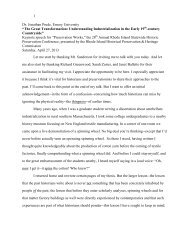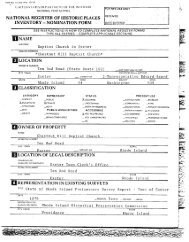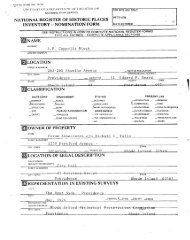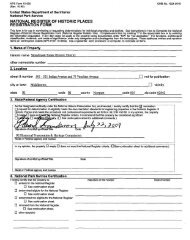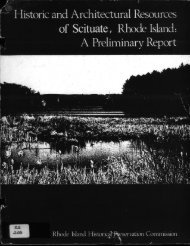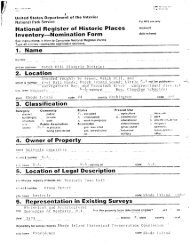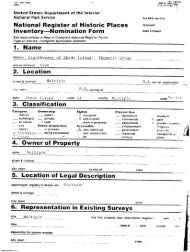National Park Service - Rhode Island Historical Preservation ...
National Park Service - Rhode Island Historical Preservation ...
National Park Service - Rhode Island Historical Preservation ...
You also want an ePaper? Increase the reach of your titles
YUMPU automatically turns print PDFs into web optimized ePapers that Google loves.
- 0MB HO. 1024-0018<br />
NPS Form Ia-BOO-i en,- 10-31-U<br />
3-92 -<br />
United States Department of the Interior<br />
<strong>National</strong> <strong>Park</strong> <strong>Service</strong><br />
<strong>National</strong> Register of Historic Places<br />
Inventory-Nomination Form -<br />
Continuation sheet 27 - - Item number 7<br />
Page 28<br />
71 -‘ - -<br />
49-4/98<br />
- Off Broad Rock Road, The Acorns c. 1850/1881-82/1894-95:<br />
The Acorns is set well off highway on a private lane running<br />
back into the woods; the Hazards titled it "Roy’s Road." The<br />
house is a large, shingle-clad, Queen Anne- style frame dwelling,<br />
2-1/2-stories, very complex and picturesque in form, with a<br />
profusion of piazzas, porche’s, porte cochere and balconies,<br />
elaborated gables. diverse dormers, and rugged stone chimneys.<br />
It has a complex history. The earliest portion was a modest midnineteenth-century<br />
cottage located off Kingstown Road and used by<br />
the Hazard family primarily as a quest house, It belonged to<br />
Rowland Hazard II in the early 1880s and he had the house greatly<br />
enlarged and embellished as a residence for his newly married<br />
son, Rowland G. Hazard ii. The result likely reflects both his<br />
own ideas and the effort of his frequent collaborator, architect<br />
Frank W. Angell. After Rowland 0. Hazard II took possession of<br />
and rebuilt another dwelling on Hazard property, Holly House,<br />
Rowland Hazard II had The Acorns moved to its present location<br />
and substantially reworked in 1894-95 for his newly married<br />
daughter, Helen Hazard Bacon. The work executed in 1894-95 is<br />
known to be by Frank Angell. The name "The Acorns" derives from<br />
the fact that this house is "offspring" of Rowland Hazard II’s<br />
house, "Oakwood." In about 1910, the Bacons added a studio #70<br />
to The Acorns property.<br />
The Acorns is the easternmost of what were six adjoining<br />
Hazard family residences ringing the south shore of Saugatucket<br />
Pond. Next west was Caroline Hazard’s house, the Scallop Shell,<br />
which was made into a nursing home in 1948 and then demolished to<br />
make way for a new nursing facility. To the northwest stood<br />
"Oakwoods" and "Holly House" -- the greatest of the family houses<br />
and both demolished in 1948 to make-way for a residential<br />
subdivision. Next west and still standing is "The Cottage" also<br />
known as the "Hazard Homestead", #17 and, on the opposite side<br />
of the mill dam, Lily Pads #15. C -<br />
72<br />
49-4/80<br />
542 Kingstown Road c. 1860:<br />
This is a very fine example of a simple Downingesque<br />
cottage. Moved to this location, the house is a 1-1/2-story<br />
clapboard structure with a 3-bay, end-gable street elevation; the<br />
rear portion of the structure is cross gabled. The broad eaves<br />
are carried on jackrafters and the windows and doors have<br />
shingled hoods. C -







